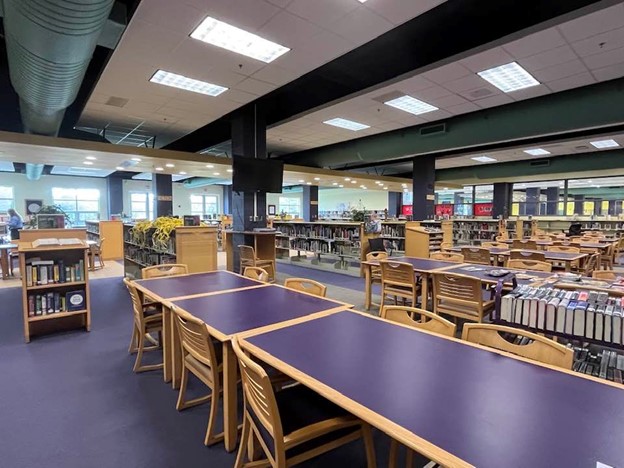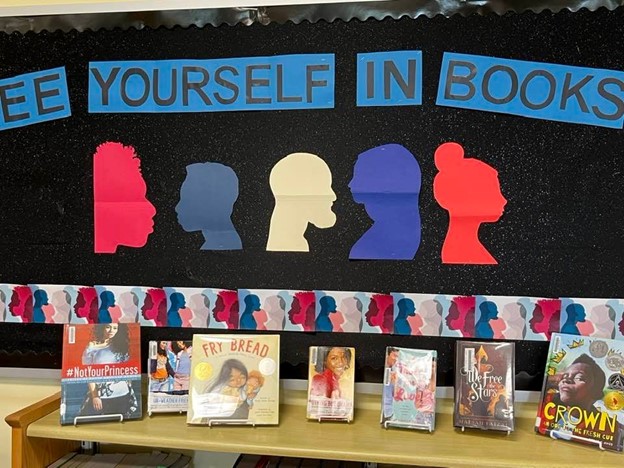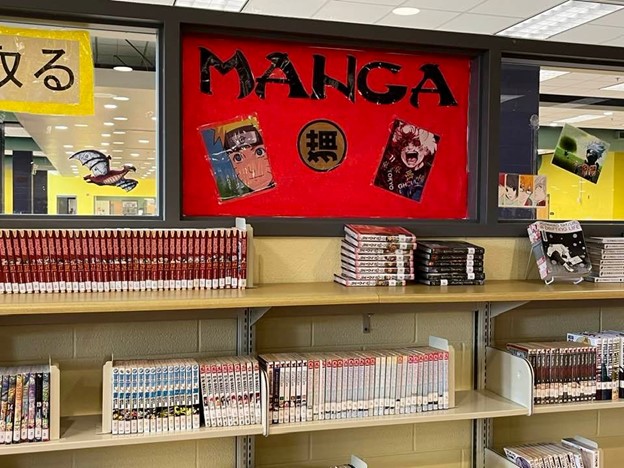The Patrick Henry High School (PHHS) library website (https://roanoke.follettdestiny.com/common/servlet/presenthomeform.do?l2m=Home&tm=Home&l2m=Home) contains no whistles or bells. It is in desperate need of updating. It contains the hours of operation and the names of the three library staff members, two librarians and one assistant. It also contains links to various topics of possible interest. The first two book review links I clicked on went to URLs that were no longer in existence, one of the author websites and one of the book award websites were no longer correct links, and the link to Patrick Henry’s “Give Me Liberty or Give Me Death” speech was no longer correct. Many of the other links were not the best examples of interesting websites for the topic listed, including book reviews, databases, featured authors, games, APA and MLA formatting guides, award-winning book lists, and information about Patrick Henry. The library catalog itself is readily accessible and easy to navigate. No special collections are evident from the website. The catalog is accessible to the public, but it is not easy to locate if you do not know where to look. The library catalog can be translated into Spanish or French, but it is not easily accessible to the visually impaired.
The PHHS Library is located on the first floor of the school, next to the cafeteria. It is a large space that is fully accessible to anyone in the building. Since summer school is currently in session, the library is not being used as frequently as it would be during the school year. Signage outside of the library clearly directs all to the entrance doors. A cart of books that had been removed from circulation for one reason or another was also in the hall with a sign that read FREE BOOKS.
When walking into the library, computer tables holding about 50 computers and two printers indicated that the space was used for classes. The librarian stated that she could accommodate up to four classes of 30-40 minutes in each 90-minute block in the space. Beyond the computers, a large space held enough tables and chairs for another 50 students. The chairs rock without tipping and making noise. The students enjoy the freedom to move. The patterns on the floor and upholstery are bright and colorful. The tabletops are bright purple, in keeping with the school colors. To one side of the tables, the circulation desk and offices for the library staff are well designed for sight lines around the entire library.

The wall next to the circulation desk contains a few reference items. The bulletin boards above the reference books highlight books available in the reference section and another invites diverse student groups to “See Yourself in Books”. Another bulletin board display highlights the Manga section. The wall opposite the cafeteria has three rooms designed as quiet spaces for small groups of six or fewer. Stacks of books fill much of the space. A few more tables and chairs separate the non-fiction and fiction sections of the library. On the far side of the library, a sitting area comprised of couches and lower tables is available for students who come to the library to read or study. The school was built in 2006 with accessibility in mind, so the stacks are completely wheelchair accessible.

Signage clearly indicated where different types of books were located, including reference, non-fiction, fiction, Manga, biographies, short story collections, and lower-level reader books. Each of the stacks had signage to indicate the books that were contained therein. Other signs pointed to the book return slot and new books. The non-fiction section of the library was organized by the Dewey decimal system. The fiction section was organized by genre and then author’s last name.
Due to the timing, there were no special services or programs observable at the time of the visit. The librarian stated that they provide numerous services during the school year, including classes related to library services, makerspace projects, and book clubs for different interest groups (L. Dennis, personal communication, July 15, 2022). She also said that many other clubs meet in the library at lunches and after school. One of the most common services provided out of the library is technology assistance. If the librarian knows how to fix the problem quickly, she often takes care of it while the student is standing at the desk. Otherwise, she will issue a loaner computer to the student while the computer technician addresses the problem.
It was very clear that this was a high school library. The collection was curated for a very diverse group of readers and designed to exhibit books of high interest. It was clear that the mission of this library emphasizes the importance of inclusiveness and diversity as addressed in Standard II of the American Association of School Librarians national standards (Rubin & Rubin, 2020, p. 164). The displays and posters were centered around interests of the students, including LGBTQ+ books, books about people of color, gaming, Manga, and sports. The librarians had pulled out grab and go books and put them in bins on top of the stacks. They also had bins of books in Spanish and a section of “Easy Reads” for English learners.

A large graphic novel section contained a variety of books, including everything from classics to Manga. The emphasis on graphic novels was reflective of the importance of the graphic novel to provide high school students with an alternative to traditional texts which promote creative and educational experiences (Serantes, 2020, as cited in Rubin & Rubin, 2020, p. 148). I was surprised by the number of books that I had read that were in the library, including many Baldacchi, King, and Grisham books. The collection in this library seemed almost as large as that of the public library I visited. The only adult books that were not represented were romances, but there were many Young Adult romance novels in the collection. This library did not contain DVDs or audiobooks.
The two librarians performed most of the normal duties of the high school librarian, including teaching classes, reading reviews and buying books, and monitoring students. The assistant created most of the displays throughout the year, checked out books, and reshelved books. The lead librarian also led the book clubs and worked with students during lunches. She seemed to have a bubblier disposition than the other librarian and built relationships with more students.
At the time of this visit, I only saw two students in the library. Both students were having a conference with an administrator. The library was in disarray as new books were being sorted and shelved and older books that no longer circulated were being culled from the collection. Computers were stacked on tables and being reimaged. The library was a hub of action, but it was disappointing to see so few students in the library during summer school.
Given the recent change in policy for acquisition of media in an adjoining school district, the variety of resources available to students made me wonder if any of the books in the PHHS library had been challenged or would be the subject of future challenges. Seeing all of the new books that were going to be added to the collection, I would like to know more about the district’s policy for acquiring new books. I would also like to know how makerspace projects has been impacted due to COVID in recent years. Finally, I would like to know how many students take advantage of the free book cart.
References
Roanoke City Public Schools. (n.d.). Patrick Henry High School Library. https://roanoke.follettdestiny.com/common/servlet/presenthomeform.do?l2m=Home&tm=Home&l2m=Home
Rubin, R. E., & Rubin, R. G. (2020). Foundations of library and information science (5th ed.). ALA Neal-Schuman.
Julie,
Thanks for sharing this library. It looks like it’s a really great space for kids to visit and utilize throughout the school year. Making these visits in the summer make it a little harder to see what this kind of library is really like when school is in session. I love that the librarian has curated a diverse selection for the students. I was wondering the same things you had questions on at the end, especially regarding how students make use of the space and resources. Is this school in Roanoke county? I read a few articles regarding their now policies regarding book collections. It’s sad how difficult they are making it for librarians to add to their collections.
You did a great job!
Maria
Maria,
This school is in Roanoke City. The struggle is real in Roanoke County. I did my interview with the lead librarian of Roanoke County. She was appalled at the new policy and stated that the newspaper did not provide the whole story about the development of the policy. The policy was basically handed to the librarians. Several librarians have since resigned from the County. It is a very sad situation. Based on what I have been seeing in our local newspaper, I feel that the ACLU and ALA may start to increase pressure on the School Board soon. It could get ugly.
Wow, I was amazed at the size of this school library! I loved your pictures. The pictures of the bulletin board really showed personality and I loved the message of the first one. That’s great that their website offered some formatting support, but could also use some major updating. That is very interesting about the book acquisition, I had not heard of anything like that before this class. Our school district recently had a school board meeting with a parent sharing concern for books in the library, but that was the extent of the conversation. I love those “Free Books” boxes, I have some students who love to pull books out of there all the time.